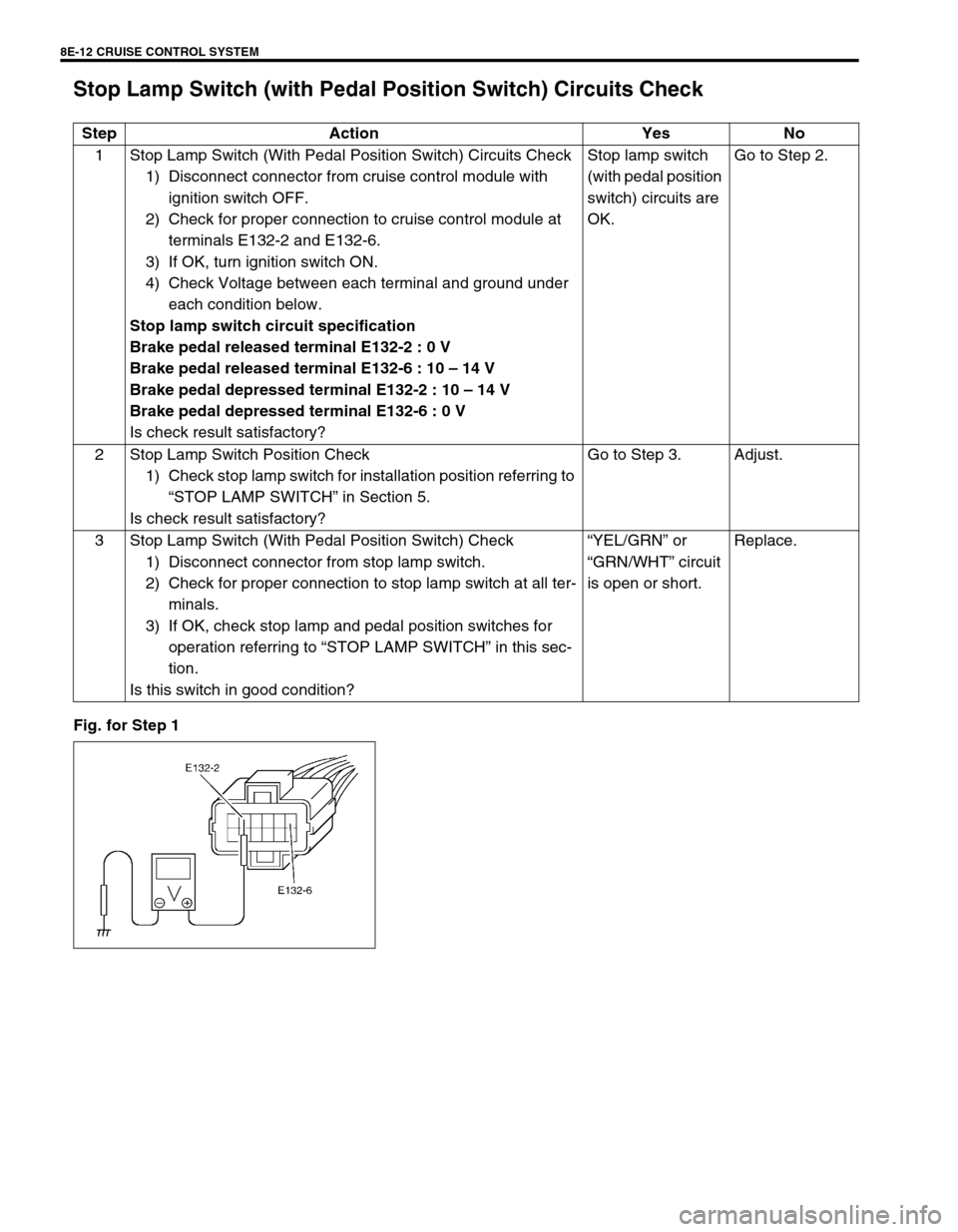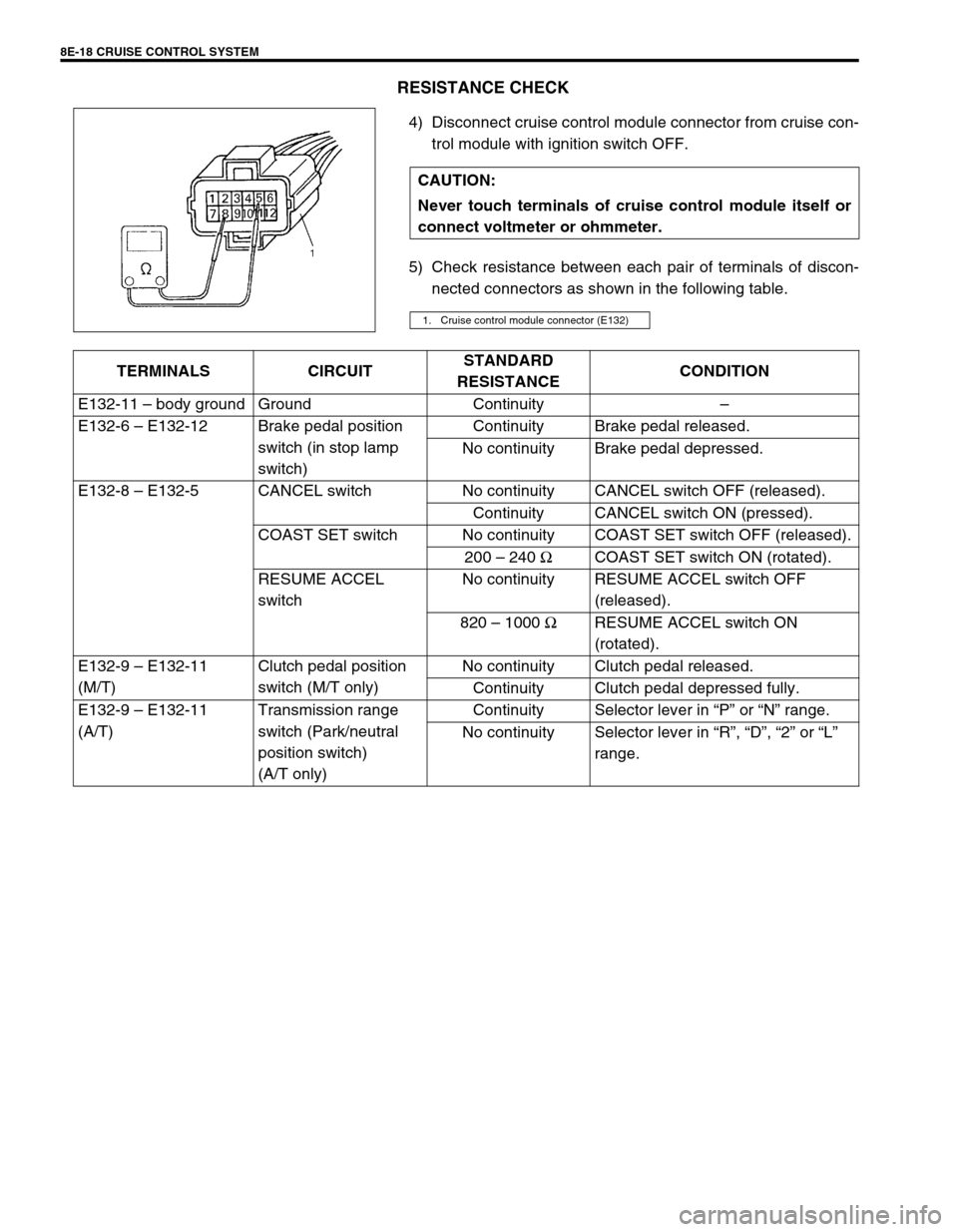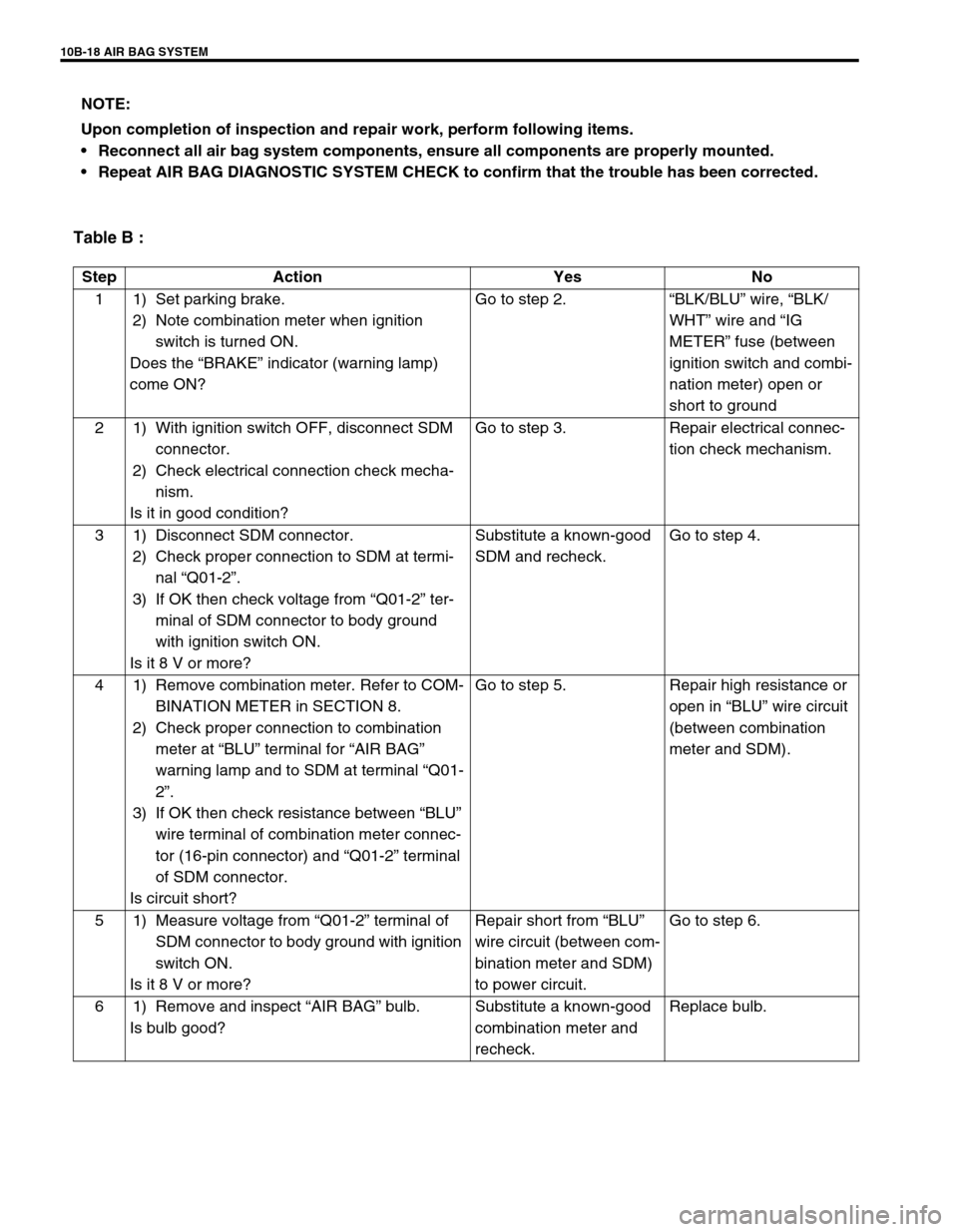Page 533 of 656

8E-12 CRUISE CONTROL SYSTEM
Stop Lamp Switch (with Pedal Position Switch) Circuits Check
Fig. for Step 1Step Action Yes No
1 Stop Lamp Switch (With Pedal Position Switch) Circuits Check
1) Disconnect connector from cruise control module with
ignition switch OFF.
2) Check for proper connection to cruise control module at
terminals E132-2 and E132-6.
3) If OK, turn ignition switch ON.
4) Check Voltage between each terminal and ground under
each condition below.
Stop lamp switch circuit specification
Brake pedal released terminal E132-2 : 0 V
Brake pedal released terminal E132-6 : 10 – 14 V
Brake pedal depressed terminal E132-2 : 10 – 14 V
Brake pedal depressed terminal E132-6 : 0 V
Is check result satisfactory?Stop lamp switch
(with pedal position
switch) circuits are
OK.Go to Step 2.
2 Stop Lamp Switch Position Check
1) Check stop lamp switch for installation position referring to
“STOP LAMP SWITCH” in Section 5.
Is check result satisfactory?Go to Step 3. Adjust.
3 Stop Lamp Switch (With Pedal Position Switch) Check
1) Disconnect connector from stop lamp switch.
2) Check for proper connection to stop lamp switch at all ter-
minals.
3) If OK, check stop lamp and pedal position switches for
operation referring to “STOP LAMP SWITCH” in this sec-
tion.
Is this switch in good condition?“YEL/GRN” or
“GRN/WHT” circuit
is open or short.Replace.
Page 538 of 656

CRUISE CONTROL SYSTEM 8E-17
Cruise Control Module and Its Circuit Inspection
VOLTAGE CHECK
Check for input or output voltage of control module (voltage between each circuit and body ground) with cruise
control module connector connected.CAUTION:
Cruise control module can not be checked by itself. It is strictly prohibited to connect voltmeter or
ohmmeter to cruise control module with coupler disconnected from it.
CIRCUIT NORMAL
VOLTAGECONDITION
Vehicle speed sensor Indicator deflection
repeated between
0 – 1 V and 3 – 5 VIgnition switch ON and cruise main switch ON. Vehicle
hoisted and rear left tire turned slowly with rear right
tire locked.
Stop lamp switch 0 – 2 V Brake pedal released.
10 – 14 V Brake pedal depressed.
Overdrive and TCC off signal
(4 A/T only) 10 – 14 V Ignition switch ON.
CRUISE indicator light 10 – 14 V Ignition switch ON.
Ground––
Brake pedal position switch
(in stop lamp switch) 10 – 14 V Ignition switch ON and brake pedal released.
0 V Ignition switch ON and brake pedal depressed.
Throttle valve opening signal
from PCM (4A/T only)Ignition switch ON.
Voltage varies as specified by graph in “THROTTLE VALVE OPENING SIG-
NAL CIRCUIT CHECK” in this section.
Cruise main switch 7 – 9V Ignition switch ON and cruise main switch released.
3 – 5 V Ignition switch ON and cruise main switch pressed.
CANCEL switch 0 – 1 V Ignition switch ON and CANCEL switch pressed.
COAST SET switch 1 – 2 V Ignition switch ON and COAST SET switch rotated.
RESUME ACCEL switch 2.5 – 4 V Ignition switch ON and RESUME ACCEL switch
rotated.
Clutch pedal position switch
(M/T only)10 – 14 V Ignition switch ON and clutch pedal released.
0 – 1 V Ignition switch ON and clutch pedal depressed fully.
Transmission range switch
(Park/Neutral position switch)
(A/T only)0 V Ignition switch ON and selector lever in “P” or “N”
range.
10 – 14 V Ignition switch ON and selector lever in “R”, “D”, “2” or
“L” range.
Cruise main switch indicator
lamp0 – 1 V Ignition switch ON.
10 – 14 V Ignition switch ON and after input main switch ON sig-
nal.
Page 539 of 656

8E-18 CRUISE CONTROL SYSTEM
RESISTANCE CHECK
4) Disconnect cruise control module connector from cruise con-
trol module with ignition switch OFF.
5) Check resistance between each pair of terminals of discon-
nected connectors as shown in the following table. CAUTION:
Never touch terminals of cruise control module itself or
connect voltmeter or ohmmeter.
1. Cruise control module connector (E132)
TERMINALS CIRCUITSTANDARD
RESISTANCECONDITION
E132-11 – body ground Ground Continuity–
E132-6 – E132-12 Brake pedal position
switch (in stop lamp
switch)Continuity Brake pedal released.
No continuity Brake pedal depressed.
E132-8 – E132-5 CANCEL switch No continuity CANCEL switch OFF (released).
Continuity CANCEL switch ON (pressed).
COAST SET switch No continuity COAST SET switch OFF (released).
200 – 240 ΩCOAST SET switch ON (rotated).
RESUME ACCEL
switchNo continuity RESUME ACCEL switch OFF
(released).
820 – 1000 ΩRESUME ACCEL switch ON
(rotated).
E132-9 – E132-11
(M/T)Clutch pedal position
switch (M/T only)No continuity Clutch pedal released.
Continuity Clutch pedal depressed fully.
E132-9 – E132-11
(A/T)Transmission range
switch (Park/neutral
position switch)
(A/T only)Continuity Selector lever in “P” or “N” range.
No continuity Selector lever in “R”, “D”, “2” or “L”
range.
Page 543 of 656
8E-22 CRUISE CONTROL SYSTEM
Stop Lamp Switch (with Pedal Position
Switch)
INSPECTION
1) Disconnect negative (–) cable at battery.
2) Disconnect stop lamp switch connector and remove stop
lamp switch from pedal bracket.
3) Check switch (2 contacts) for resistance under each of the
following each conditions.
If check result is not satisfactory, replace stop lamp switch.
Stop lamp switch specification
Between terminals “1” and “3” (Contact for stop lamp)
FREE (2) : Continuity, PUSH (1) : No continuity
Between terminals “2” and “4” (Contact for brake pedal
position)
FREE (2) : No continuity, PUSH (1) : Continuity
4) Install stop lamp switch and adjust its position referring to
Section 5.
Page 595 of 656

10B-18 AIR BAG SYSTEM
Table B :
NOTE:
Upon completion of inspection and repair work, perform following items.
Reconnect all air bag system components, ensure all components are properly mounted.
Repeat AIR BAG DIAGNOSTIC SYSTEM CHECK to confirm that the trouble has been corrected.
Step Action Yes No
1 1) Set parking brake.
2) Note combination meter when ignition
switch is turned ON.
Does the “BRAKE” indicator (warning lamp)
come ON?Go to step 2.“BLK/BLU” wire, “BLK/
WHT” wire and “IG
METER” fuse (between
ignition switch and combi-
nation meter) open or
short to ground
2 1) With ignition switch OFF, disconnect SDM
connector.
2) Check electrical connection check mecha-
nism.
Is it in good condition?Go to step 3. Repair electrical connec-
tion check mechanism.
3 1) Disconnect SDM connector.
2) Check proper connection to SDM at termi-
nal “Q01-2”.
3) If OK then check voltage from “Q01-2” ter-
minal of SDM connector to body ground
with ignition switch ON.
Is it 8 V or more?Substitute a known-good
SDM and recheck.Go to step 4.
4 1) Remove combination meter. Refer to COM-
BINATION METER in SECTION 8.
2) Check proper connection to combination
meter at “BLU” terminal for “AIR BAG”
warning lamp and to SDM at terminal “Q01-
2”.
3) If OK then check resistance between “BLU”
wire terminal of combination meter connec-
tor (16-pin connector) and “Q01-2” terminal
of SDM connector.
Is circuit short?Go to step 5. Repair high resistance or
open in “BLU” wire circuit
(between combination
meter and SDM).
5 1) Measure voltage from “Q01-2” terminal of
SDM connector to body ground with ignition
switch ON.
Is it 8 V or more?Repair short from “BLU”
wire circuit (between com-
bination meter and SDM)
to power circuit.Go to step 6.
6 1) Remove and inspect “AIR BAG” bulb.
Is bulb good?Substitute a known-good
combination meter and
recheck.Replace bulb.